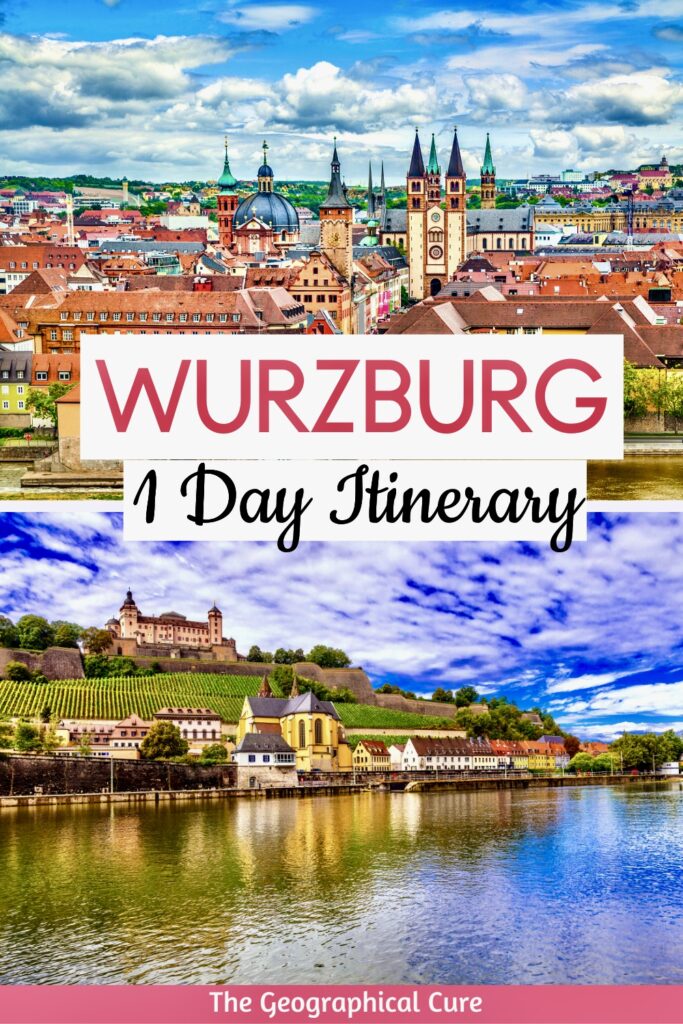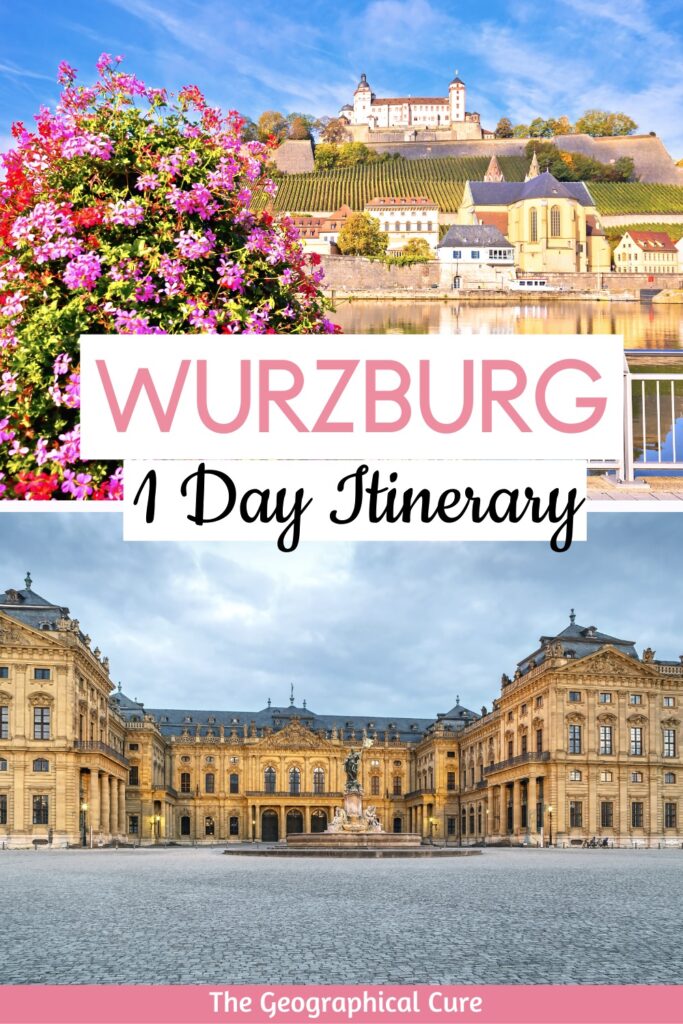Würzburg, in the heart of Germany’s Franconia region, offers a rich mix of history, culture, and scenic beauty. Known for the glamorous Residenz, the city impresses with its art, architecture, and cobbled lanes.
Located along the Main River and surrounded by vineyards, Würzburg is also a haven for wine lovers.
The city’s old town is filled with historic sites like the Marienberg Fortress and the Old Main Bridge.
Its cultural scene is vibrant, with numerous wine festivals, markets, and the famous Mozartfest.
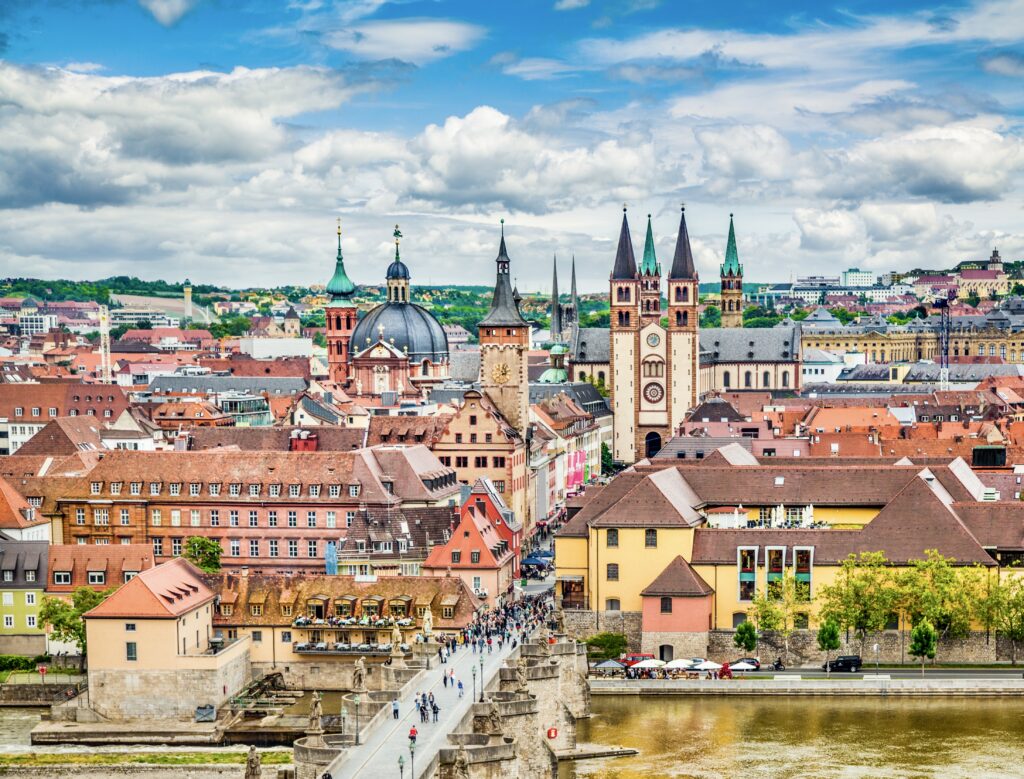
Snapshot Of One Day In Würzburg
Here’s a quick glance at what you can see with this itinerary:
- Würzburg Residence
- Court Gardens
- Marienberg Fortress
- Old Main Bridge
- Old Town
- Juliusspiittal
This itinerary covers the highlights of Würzburg and gives you a taste of its history, culture, and culinary delights. Remember to check the opening hours of the attractions and make reservations where necessary.
You could also book a guided walking tour to get oriented.
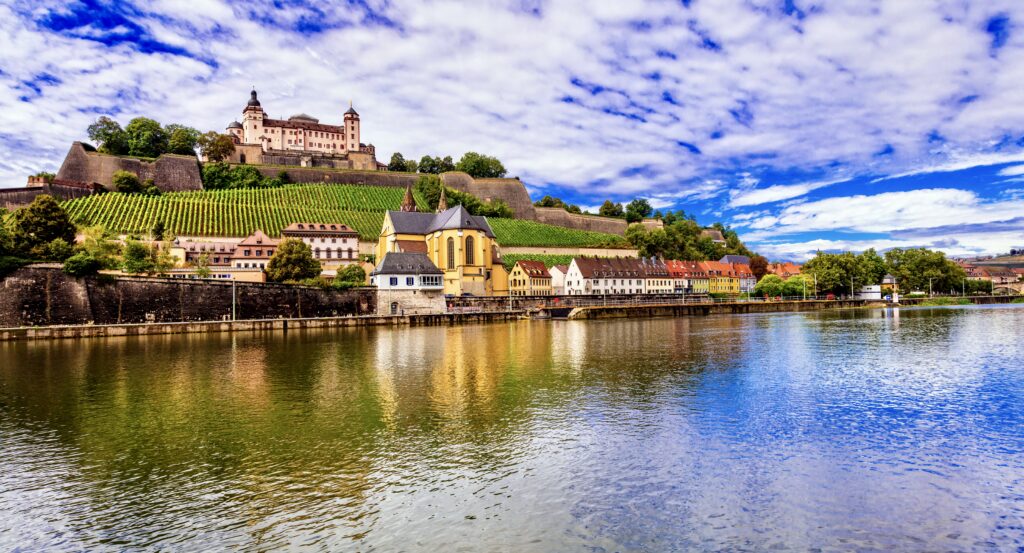
One Day In Würzburg Itinerary
Marienberg Fortress
Start your day with a visit to the Marienberg Fortress, which offers a stunning panoramic view of the city and the Main River.
The medieval castle was the first residence of the prince-bishops. It was enlarged into a Renaissance palace before they decamped for the swishy Residence. And later, Baroque elements were added.
Explore the Mainfränkisches Museum inside the fortress, which houses Franconian artworks. Don’t miss the collection of very delicate linderwood carvings by renowned sculptor Tilman Riemenschneider.
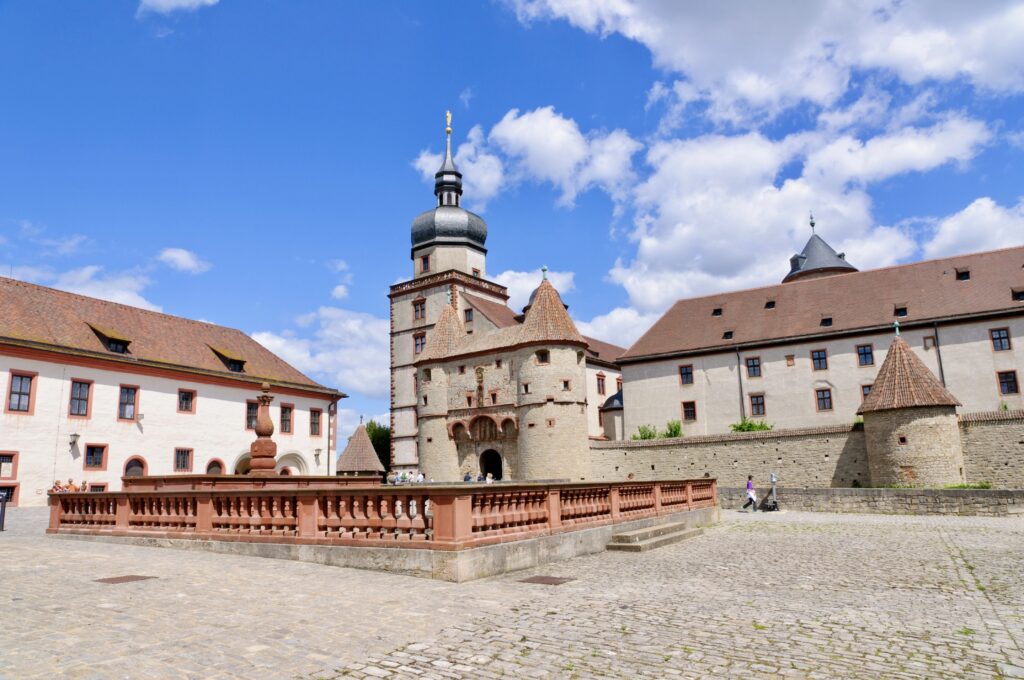
The walk up to the fortress can be steep, so consider taking one of the (unfortunately infrequent) buses if you prefer.
The fortress is currently being restored. But the second courtyard of the castle, known as the Echterhof, along with various viewpoints around the castle, remain open to visitors.
You can still take a guided tour of the castle and the museum is open for visitors.
Tip: From the Old Bridge, it’s about a 20-30 minute walk up to the fortress and you should plan to spend an hour or more inside.
Würzburg Residence
Next, head to the Würzburg Residence. Constructed over 60 years, it’s one of Germany’s most significant Baroque palaces and a UNESCO World Heritage Site.
This palace is often referred to as the “German Versailles.” It offers a unique and less crowded experience compared to its French counterpart.
Inside, you’ll find breathtaking interiors, including the renowned work of Giovanni Battista Tiepolo. His ceiling fresco is massive, covering the vast expanse of the palace’s vault.
It illustrates the four continents known at the time, with each depicted in a manner reflecting the era’s perspectives.
The White Hall, or Imperial Hall, is another marvel within the palace. Adorned with sparkling white stucco and chandeliers, it gives an illusion of shimmering fabric and is considered one of the most exquisite ballrooms worldwide.
Another highlight is the Mirror Cabinet, where 600 mirrors are not just reflective surfaces but are intricately painted and etched in gold leaf. It creates a lavish spectacle unlike any other.
After exploring the Residence, take a relaxing walk in the adjoining Court Gardens, a beautiful example of Baroque garden design.
Tips: Allow around 1.5 to 2 hours for your visit. You can only visit via a guided tour. Tours in English are every day at 11:00 am and 3:00 pm.
>>> Click here to book a private city tour that includes the Residence
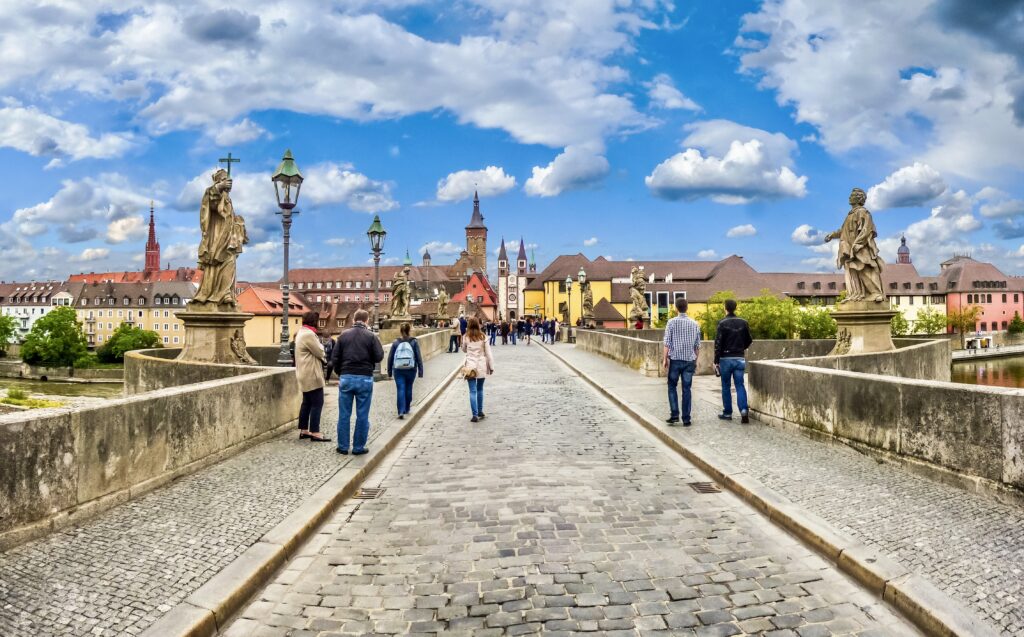
Enjoy a Traditional Franconian Lunch
Head back to the town center and enjoy lunch at one of the traditional Franconian restaurants or cafes. I had lunch at the adorable Café Wunschlos Glücklich.
Try local specialties like Schäufele (pork shoulder) or Bratwurst (German sausage). You can also grab some traditional German sausages or street food to go at a wurstlestand.
Walk Across the Old Main Bridge
After lunch, walk across the Alte Mainbrücke (Old Main Bridge). The bridge dates from 1133.
It was embellished in the 18th century with Baroque famous statues of bishops and saints. Along the bridge, local vendors set up stalls where they sell regional wines.
The bridge is a lively social gathering place, especially in the evenings and during warmer months. People enjoy glasses of wine while taking in the scenic views of the river and the city.
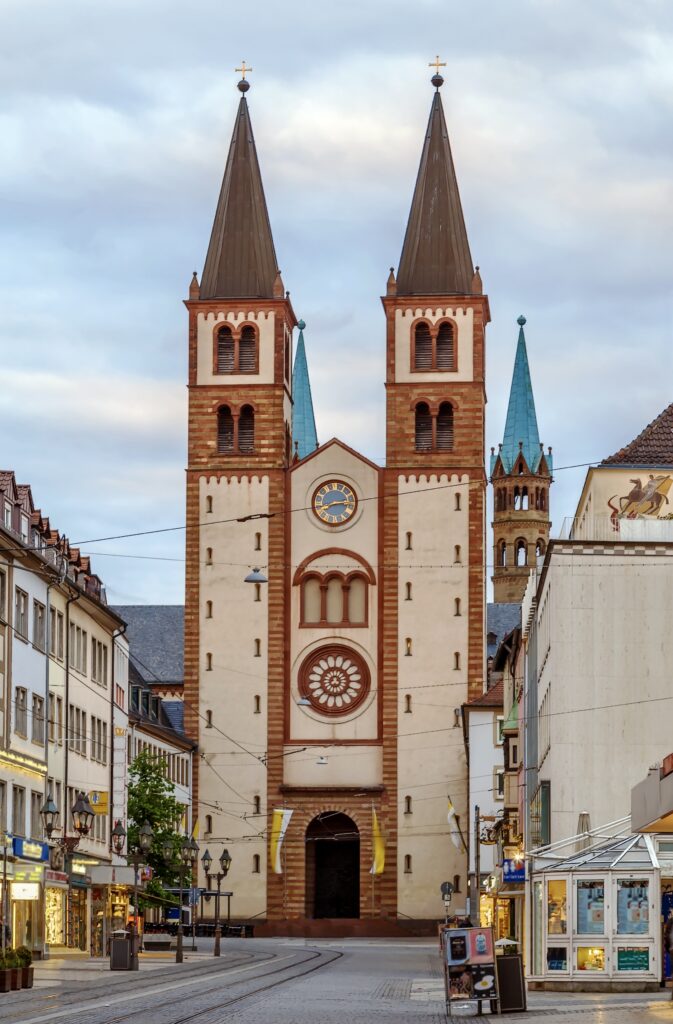
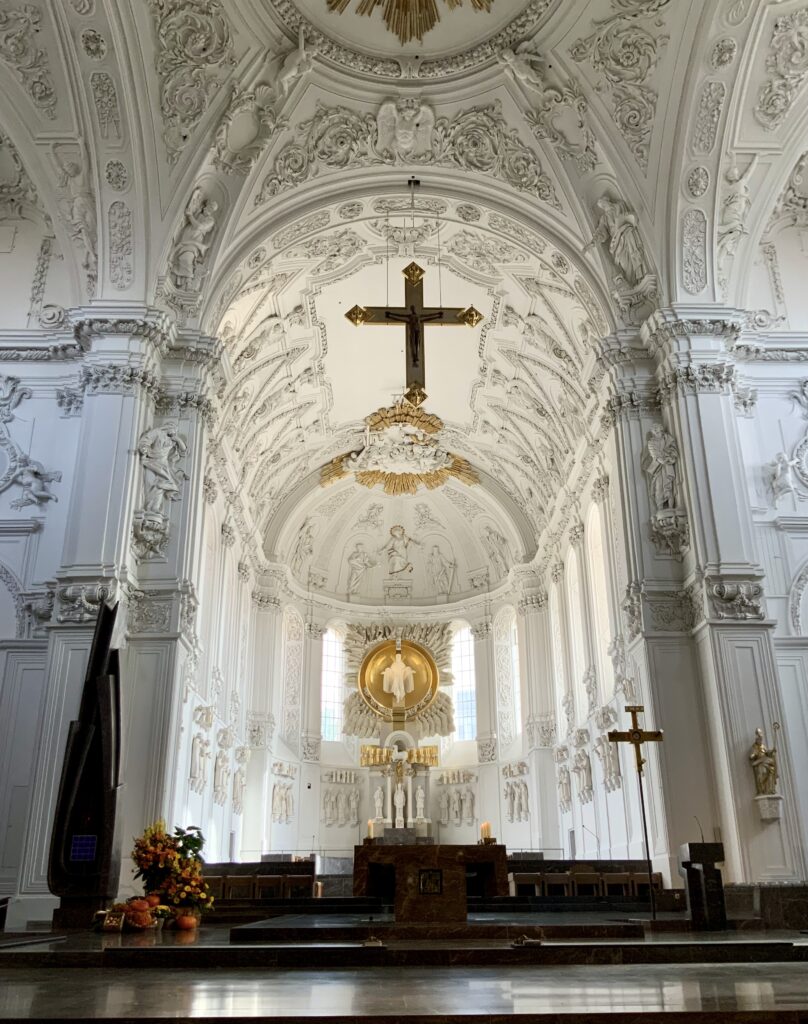
Explore the Old Town
Then, wander through Würzburg’s charming old town. It’s an absolutely charming area with winding cobble streets and historic buildings.
Würzburg Cathedral is a 13th century Romanesque edifice that was badly damaged during WWII, but rebuilt. It contains the tombs of Schonborns, the most prominent prince-bishops.
The cathedral is dedicated to Saint Kilian, an Irish missionary who is the patron saint of Würzburg. He was sent to evangelize the area in the 7th century and is a central figure in the region’s Christian history.
Inside, the cathedral houses numerous works of art, including sculptures, altars, and tombstones.
Of particular note is the Schönborn Chapel, a masterpiece of Baroque architecture designed by Balthasar Neumann. It’s almost blindingly white. The stucco decorative elements give the chapel a distinctive and elegant appearance.
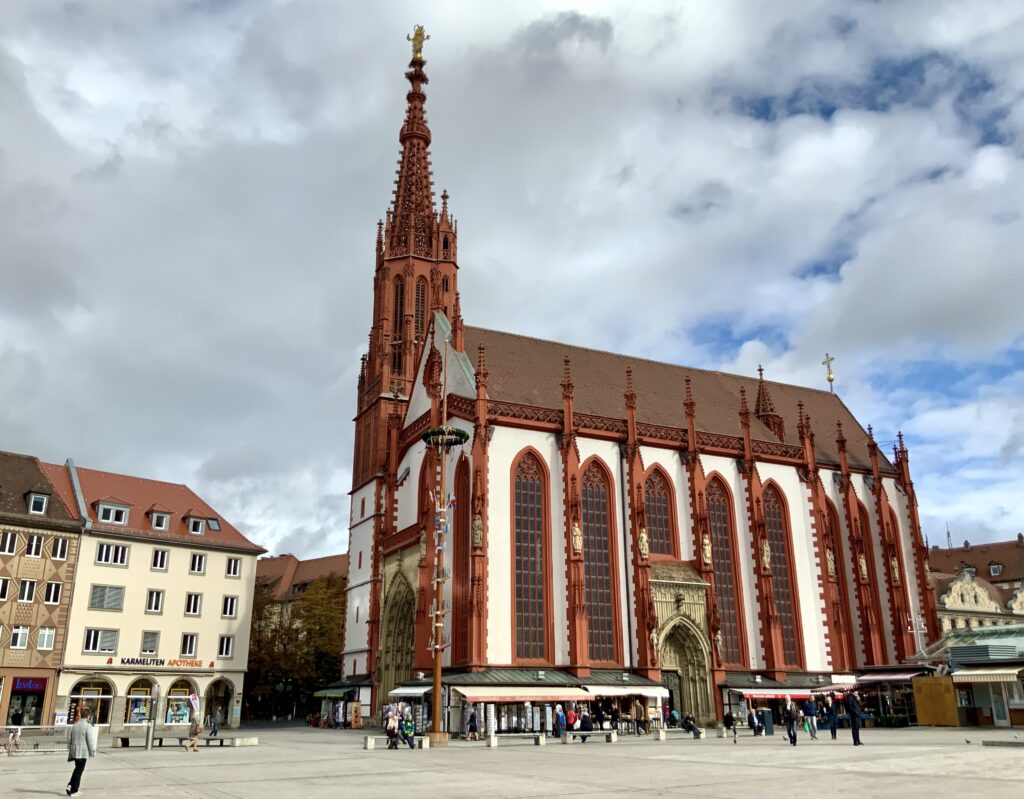
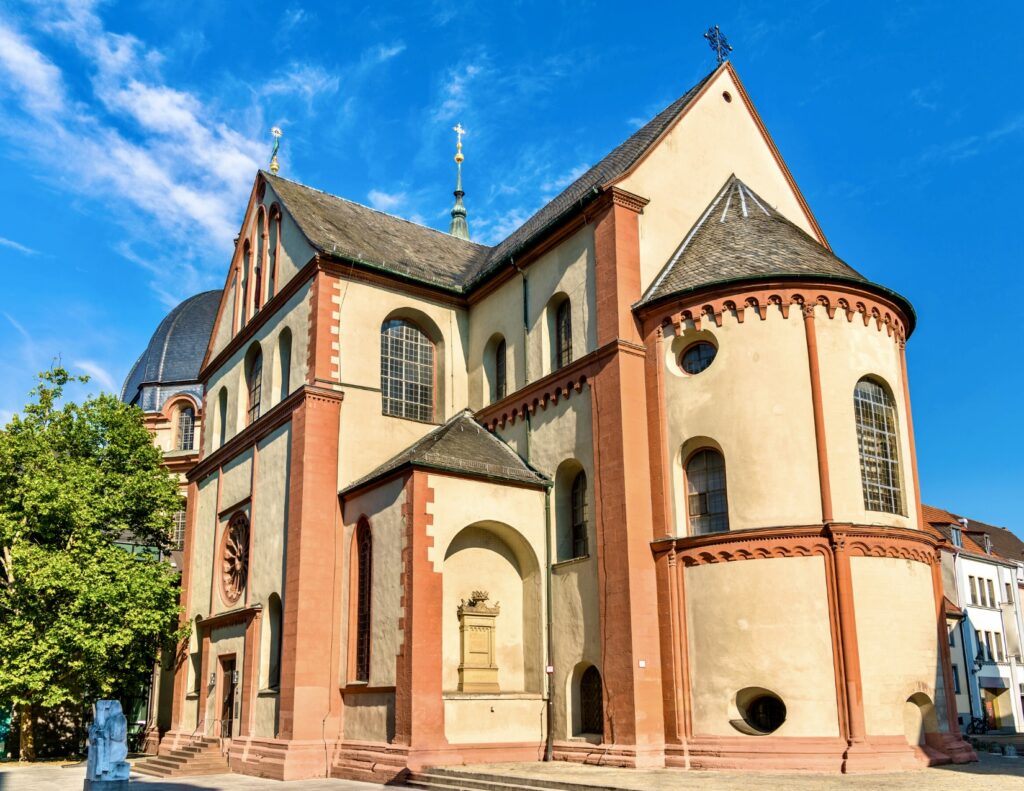
The adjacent Neumünster Church is a Romanesque basilica lavishly rebuilt in a Baroque style.
It’s the resting place of the saintly Kilian. To the rear is a tiny green space with a memorial to the much loved troubadour Wather von de Vogelwide.
The nearby Marktplatz is graced by the gorgeous Rococo mansion known as Haus sum Falken and by the striking Gothic Marienkapelle.
Tip: The Falkenhaus is home to the tourist office if you need a map or information.
The red and white chapel was built in honor the Virgin Mary. There’s a depiction of the annunciation above its entrance. Inside, there are paintings of the Beautiful Madonna and the Silver Madonna.
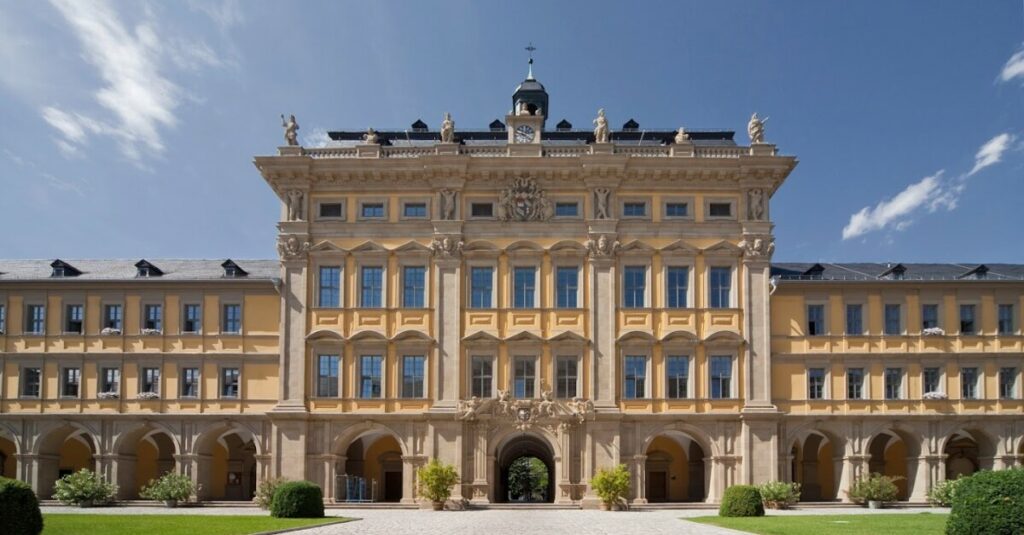
Visit the Juliusspital
Stop by the Juliusspital, a historic hospital that is also home to one of the largest wine estates in Germany.
The Juliusspital is a remarkable complex that features a Baroque-style hospital building, a church, and stunning gardens. This architectural gem showcases the Baroque style that Würzburg is famous for and is a significant part of the city’s heritage.
What also sets the Juliusspital apart is its renowned wine estate, sprawling over 430+ acres. The vineyard is celebrated for producing a variety of wines, especially its exceptional Silvaner and Riesling.
For wine enthusiasts, a visit to the Juliusspital is not complete without a tour of its historic wine cellar. You can also arrange wine tastings, offering a perfect way to experience the flavors and traditions of the beautiful town.
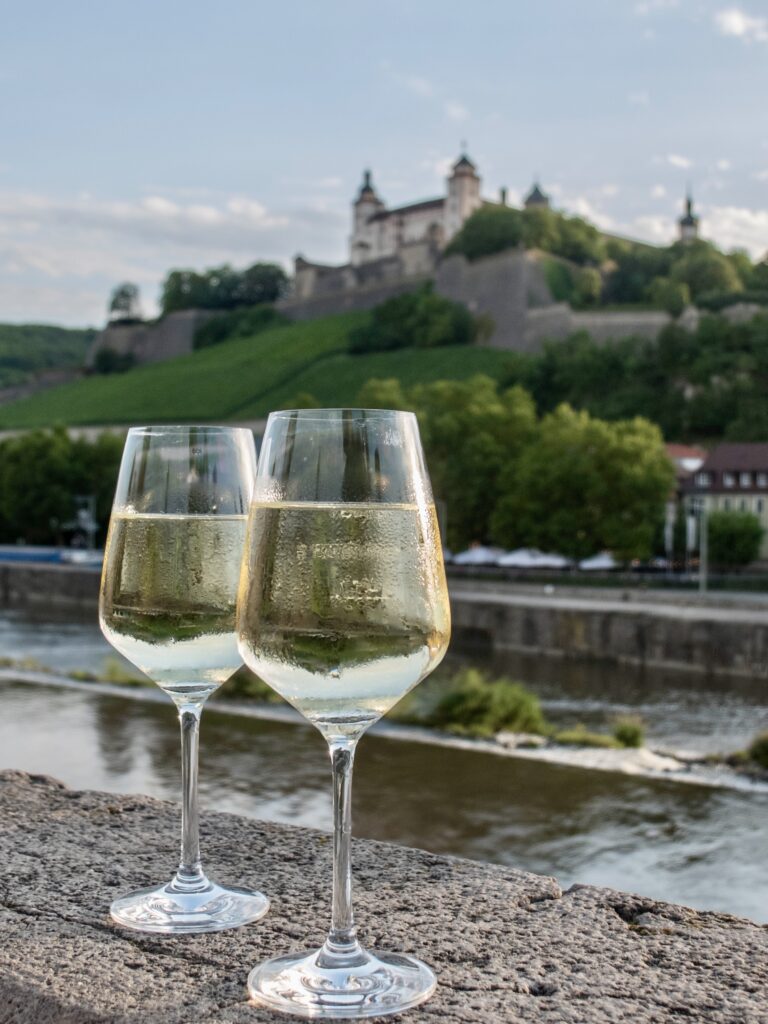
Dinner and Local Wine
For dinner, try a local wine tavern or restaurant in the city center, where you can enjoy regional wines, particularly the prize-winning Franconian Riesling.
You can buy some yourself to take home. They’re sold in teardrop shaped Bocksbeuutel bottles.
A good place for sampling the goods is the Haus des Frankenweins. Organized tastings are offered in a cozy paneled chambers.
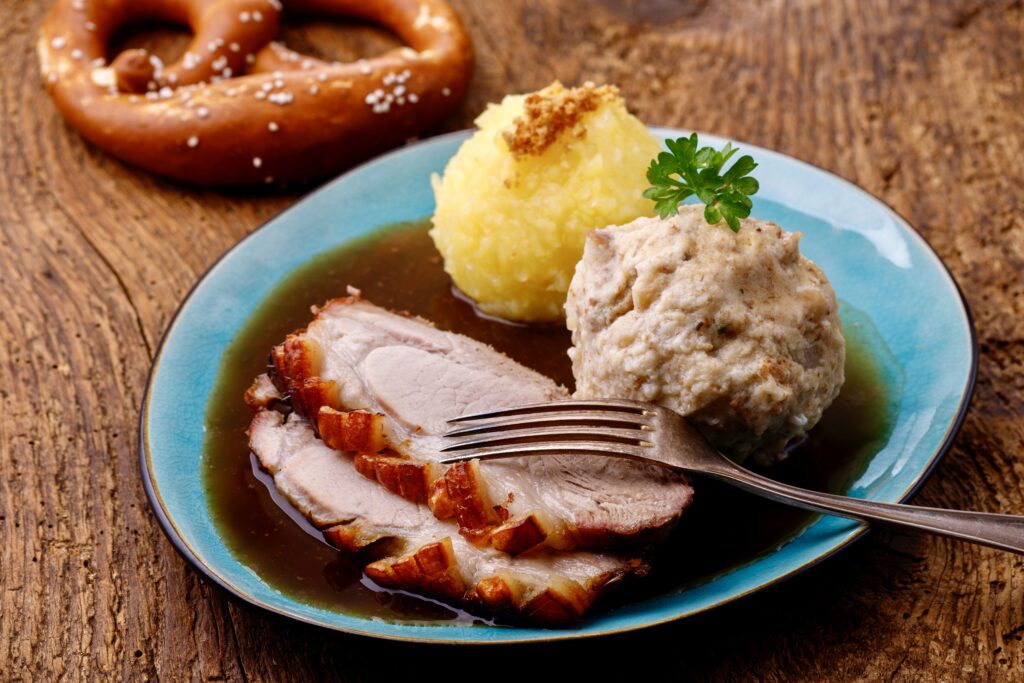
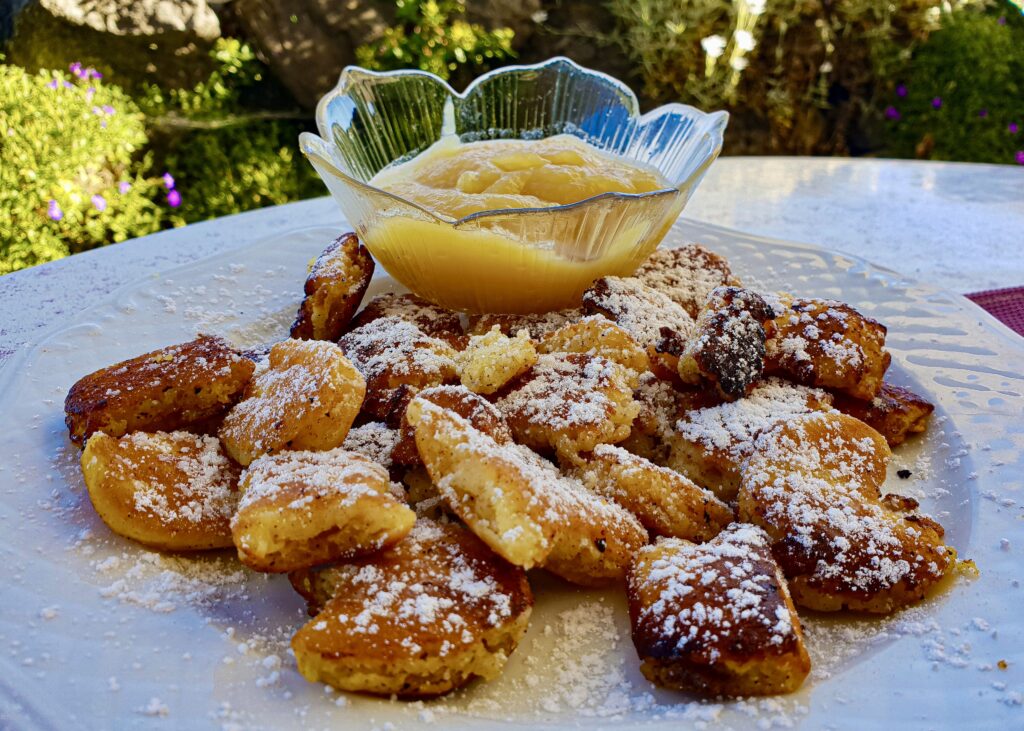
For dinner, there are some great restaurants popular among locals and tourists alike. For traditional Franconian food, check out Alte Mainmühle, Backöfele, Bürgerspital Weinstuben, and Stachel.
If you want something more modern, Nikolaushof and KUNO 1408 offer innovative cuisine.
For dessert, try the Kaiserschmarrn. It’s a fluffy shredded pancake typically served with powdered sugar and various accompaniments like applesauce.
End your day with a relaxing walk along the Main River Promenade, enjoying the evening atmosphere of the city.
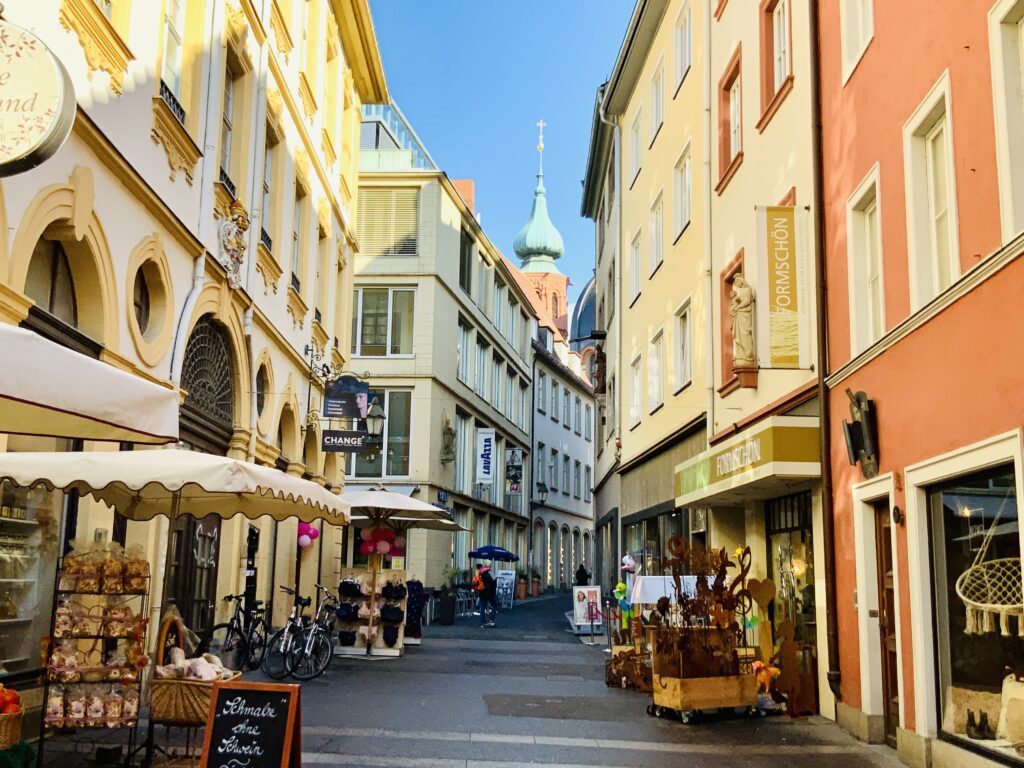
Tips For Spending One Day in Würzburg
How To Get To Würzburg
Würzburg is in northern Bavaria. It’s about 1.5 hours from Frankfurt and 3 hours from Munich.
I visited on a day trip from Nuremberg, about a 1.5 hour drive.
How to Get Around Würzburg
Wurzburg is a compact town that’s very walkable. Parts of it are quite pedestrian-friendly, especially in the historic city center.
You can also get around on buses, trams, and the Bimmelbahn Train.
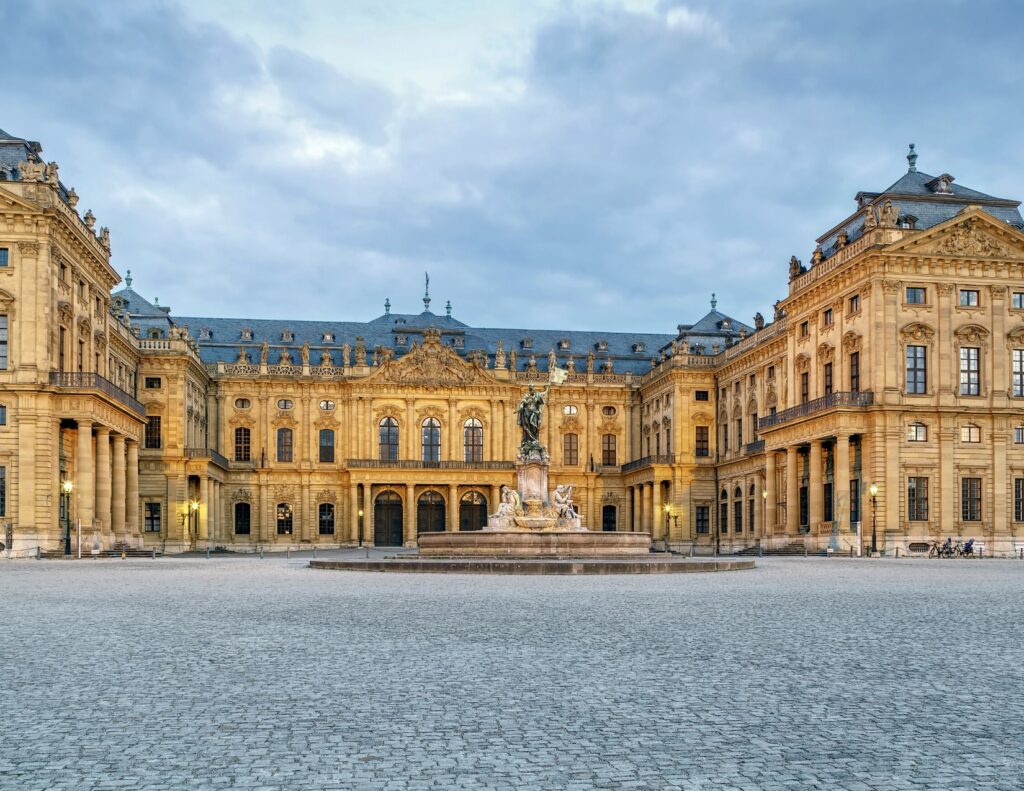
Where To Stay In Würzburg
If you are staying overnight, there are some good hotel options.
Schlosshotel Steinburg: Overlooking the city and the River Main, this hotel offers stunning views and luxurious accommodations. It’s a bit outside the city center, providing a quiet, castle-like experience.
Dorint Hotel Würzburg: A modern hotel offering comfortable and contemporary rooms, the Dorint is well-suited for both business and leisure travelers. It’s centrally located with easy access to tourist spots and business areas.
Best Western Premier Hotel Rebstock: This is a historic and elegant hotel known for its excellent service and comfortable rooms. It is located near many of Würzburg’s main attractions and also houses the renowned KUNO 1408 restaurant.
GHOTEL hotel & living Würzburg: If you’re seeking a more contemporary design and affordable prices, the GHOTEL is a great choice. It features modern rooms and is located close to the main train station.

When To Visit
I think the best time to visit is late spring or early fall. Summer will be hot and crowded and winter will be pretty chilly. But the town does host a lovely Christmas market called Würzburger Weihnachtsmarkt.
You may want to come during the Mozart Festival. It’s an annual event, typically held from late May to early July.
This festival celebrates the works of Wolfgang Amadeus Mozart and other classical composers through a series of concerts and performances. They’re often held in historic and culturally significant venues, such as the Würzburg Residence, the Kaisersaal, and the Residence’s Hofkirche.
Tip: The exact dates can vary each year, so it’s advisable to check the website for specific dates and events.
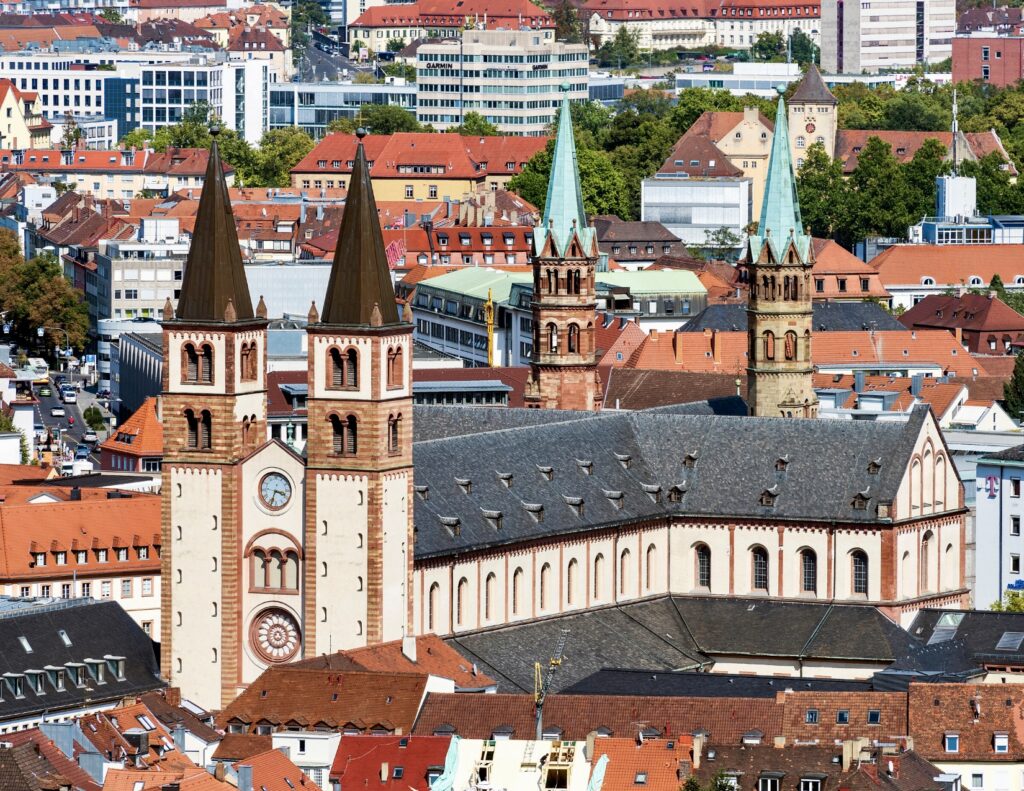
Is Wurzburg Worth Visiting?
While not as famous as other towns like Rothenburg ob der Tauber or Bamberg, Wurzburg is a delightful hidden gem. The Residence and the enchanting historic center make it well worth a visit and the town can easily be covered in a day.
I hope you’ve enjoyed my one day in Würzburg itinerary. You may find these other Germany travel guides useful:
- Prettiest Towns in Germany
- 10 Day Bavaria Itinerary
- Landmarks in Germany
- Must See Sites on the Romantic Road
- 24 Hours in Munich
- 4 Day Itinerary for Munich
- Guide To Neuschwanstein Castle
- Guide To Bamberg
- Tips for Traveling in Germany
- Castles in Bavaria
Pin it for later.

